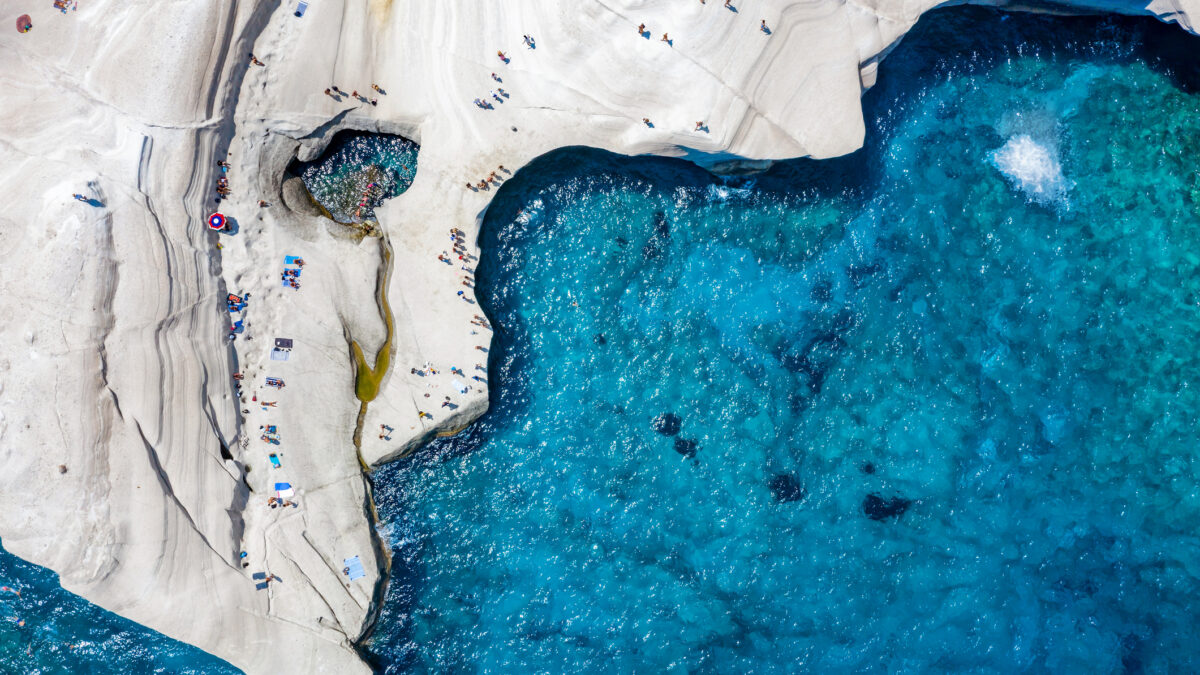The southwestern-most and fifth-largest island in the Cyclades, Milos is perennially lauded in both the domestic and foreign press as one of the most gorgeous places on earth. Intrinsically connected with the island is the Aphrodite of Milos (Venus de Milo) sculpture – currently a major exhibit at the Louvre in Paris – which played a major role in the island’s fame.
Milos is a volcanic island blessed with ample mineral wealth; thanks to this and its location on the maritime route from mainland Greece to Crete, it has been inhabited since prehistoric times, developing major commercial activity and a noteworthy culture in the process. The island drew its name from the word ‘vilos’, ancient Greek for sheep.
It is renowned for its singular beauty, striking, unique beaches, natural wealth and culinary heritage. The island’s rather more rugged western side is part of the NATURA network and is a prime destination for hikers looking to explore a beautiful natural environment.
The island’s main settlement is Plaka, a picturesque village featuring island architecture and quaint stone-paved alleyways. The settlement is also home to a Venetian castle and the church of Panagia Schoiniotissa, while visitors to Archaeological Museum of Milos can admire a faithful copy of the renowned Aphrodite of Milos. Other settlements include the port of Adamantas, which boasts one of the largest natural harbours in the Mediterranean and has a Mining Museum; the picturesque fishing village of Klima and Trypiti; the first capital of the island, Zefyria; and Apollonia with its famous Papafragkas cave.
Milos is renowned worldwide for its beaches. The moonscapes of Sarakiniko beach, with its bone-white rocks and clear blue waters, are a must-see for any visitor to the island. Indeed, those who choose Milos for their holidays are sure to remember the island’s beaches for a lifetime, given their uniqueness and dazzling palette. Katergo, Kleftiko, Papafragkas, Gerontas, Plaka, Fyri, and Palaiochori are just a few of the must-visit beaches on the island, though it is unfair to single any of them out. As a rule, visitors should try to see them all.
Cuisine
Milos has been inhabited since prehistoric times; the peoples who have called the island home over the centuries have left their indelible mark on its rich culinary heritage, which exhibits numerous multicultural elements. The island’s volcanic terrain, beyond its lunar landscapes and singular natural beauty, plays a major role in the production of the excellent local products.
Livestock breeding is a vital activity on Milos and is the source of many local products. As a result, the island is home to large flocks of sheep and goats. In addition to forming the basis of cuisine on Milos, they also enable the production of delicious cheeses. Most of the island’s dairy production is based on goat’s milk, and it is worth mentioning that the local cheeses are often matured in the island’s caves, which possess the ideal temperature and humidity conditions for the job. The local Protected Designation of Origin (PDO) dry cheese is actually a type of long-maturation manoura. Manoura is the basis for a number of locally produced cheeses. It is considered a fresh cheese if consumed immediately, semi-fresh if consumed 20 days after production, in which iteration it is often used as filling in traditional small pies, melichloro (honey-yellow) 2 months after production, and fully dry more than 6 months after production. The island’s dairy production is rounded out by the local myzithra, skotyri and xinomyzithra cheeses.
Another local product is ‘beltes’, a paste that is made from the cherry tomatoes grown on the island and that forms the basis of traditional recipes such as goat in red sauce. It is almost ubiquitous in the cuisine of Milos, consumed by itself as an appetizer with bread or barley rusks, as a side dish with aliada (a type of garlic dip made with flour) or as sauce in lasagna, also known on the island as ‘skordolazana’. In addition to lasagna, the island also produces another type of handmade pasta known as matsi.
The island’s cuisine features a dizzying variety of pies: myzithropitakia, tsimbita, skaltsounia, manouropita, and plakopita, just to name a few. As far as sweets go, Milos is famous for its watermelon pie.
Visitors to the island should not miss the exceptional local meat dishes, with goat in all its culinary glory, as well as the freshly caught fish and seafood. Dishes most certainly worth sampling include fish savoro (fried small fish preserved in a sauce made of vinegar, flour and herbs, most often rosemary) and the local versions of tomato and zucchini fritters. Standout sweets include koufeto (a nuptial spoon sweet) made with white squash, honey, and rosewater.
How to get there
Milos sits at the southwestern edge of the Cyclades and is serviced by ferry from the ports of Piraeus and Lavrio as well as by air.










